Wenchao Ding
STREAMINGGS: Voxel-Based Streaming 3D Gaussian Splatting with Memory Optimization and Architectural Support
Jun 09, 2025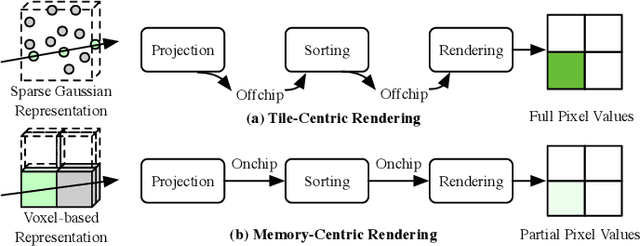



Abstract:3D Gaussian Splatting (3DGS) has gained popularity for its efficiency and sparse Gaussian-based representation. However, 3DGS struggles to meet the real-time requirement of 90 frames per second (FPS) on resource-constrained mobile devices, achieving only 2 to 9 FPS.Existing accelerators focus on compute efficiency but overlook memory efficiency, leading to redundant DRAM traffic. We introduce STREAMINGGS, a fully streaming 3DGS algorithm-architecture co-design that achieves fine-grained pipelining and reduces DRAM traffic by transforming from a tile-centric rendering to a memory-centric rendering. Results show that our design achieves up to 45.7 $\times$ speedup and 62.9 $\times$ energy savings over mobile Ampere GPUs.
LiveVLM: Efficient Online Video Understanding via Streaming-Oriented KV Cache and Retrieval
May 21, 2025Abstract:Recent developments in Video Large Language Models (Video LLMs) have enabled models to process long video sequences and demonstrate remarkable performance. Nonetheless, studies predominantly focus on offline video question answering, neglecting memory usage and response speed that are essential in various real-world applications, such as Deepseek services, autonomous driving, and robotics. To mitigate these challenges, we propose $\textbf{LiveVLM}$, a training-free framework specifically designed for streaming, online video understanding and real-time interaction. Unlike existing works that process videos only after one question is posed, LiveVLM constructs an innovative streaming-oriented KV cache to process video streams in real-time, retain long-term video details and eliminate redundant KVs, ensuring prompt responses to user queries. For continuous video streams, LiveVLM generates and compresses video key-value tensors (video KVs) to reserve visual information while improving memory efficiency. Furthermore, when a new question is proposed, LiveVLM incorporates an online question-answering process that efficiently fetches both short-term and long-term visual information, while minimizing interference from redundant context. Extensive experiments demonstrate that LiveVLM enables the foundation LLaVA-OneVision model to process 44$\times$ number of frames on the same device, and achieves up to 5$\times$ speedup in response speed compared with SoTA online methods at an input of 256 frames, while maintaining the same or better model performance.
LMPOcc: 3D Semantic Occupancy Prediction Utilizing Long-Term Memory Prior from Historical Traversals
Apr 18, 2025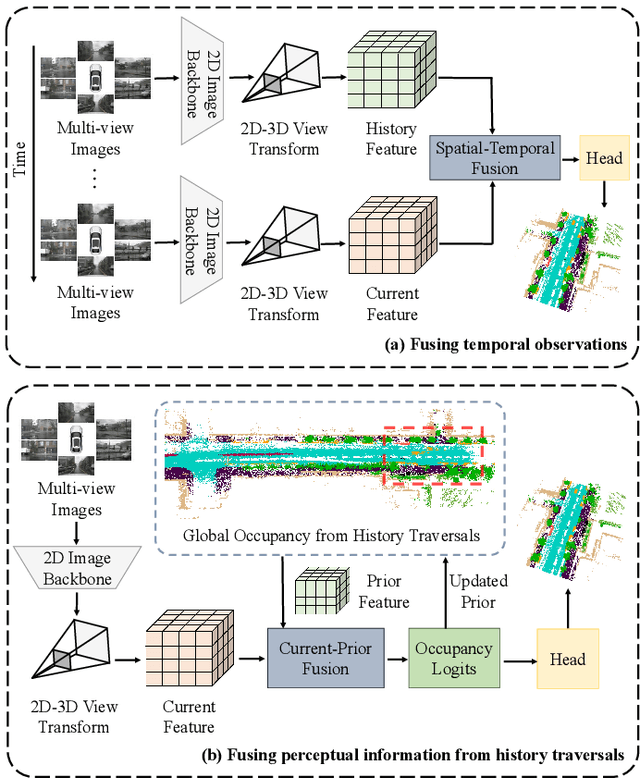
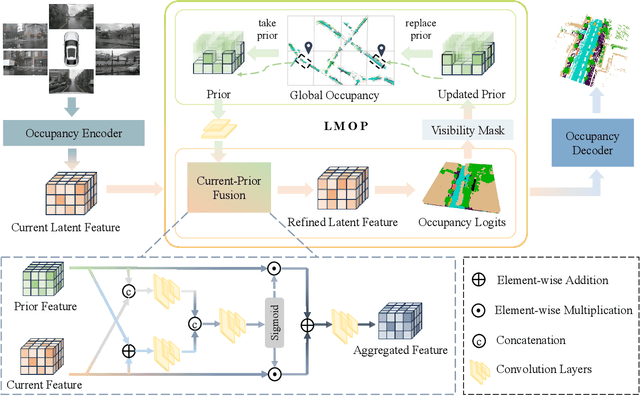
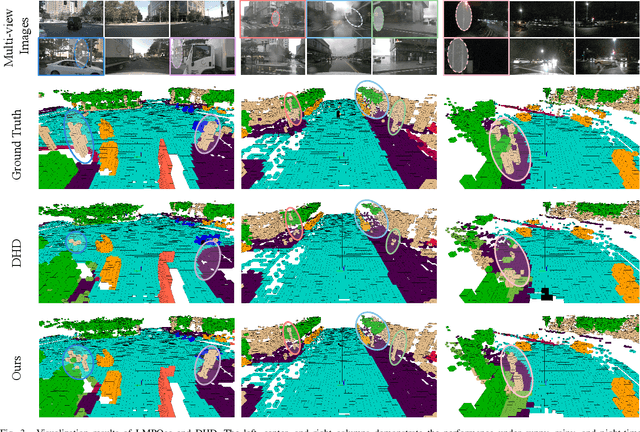

Abstract:Vision-based 3D semantic occupancy prediction is critical for autonomous driving, enabling unified modeling of static infrastructure and dynamic agents. In practice, autonomous vehicles may repeatedly traverse identical geographic locations under varying environmental conditions, such as weather fluctuations and illumination changes. Existing methods in 3D occupancy prediction predominantly integrate adjacent temporal contexts. However, these works neglect to leverage perceptual information, which is acquired from historical traversals of identical geographic locations. In this paper, we propose Longterm Memory Prior Occupancy (LMPOcc), the first 3D occupancy prediction methodology that exploits long-term memory priors derived from historical traversal perceptual outputs. We introduce a plug-and-play architecture that integrates long-term memory priors to enhance local perception while simultaneously constructing global occupancy representations. To adaptively aggregate prior features and current features, we develop an efficient lightweight Current-Prior Fusion module. Moreover, we propose a model-agnostic prior format to ensure compatibility across diverse occupancy prediction baselines. LMPOcc achieves state-of-the-art performance validated on the Occ3D-nuScenes benchmark, especially on static semantic categories. Additionally, experimental results demonstrate LMPOcc's ability to construct global occupancy through multi-vehicle crowdsourcing.
Drive in Corridors: Enhancing the Safety of End-to-end Autonomous Driving via Corridor Learning and Planning
Apr 10, 2025Abstract:Safety remains one of the most critical challenges in autonomous driving systems. In recent years, the end-to-end driving has shown great promise in advancing vehicle autonomy in a scalable manner. However, existing approaches often face safety risks due to the lack of explicit behavior constraints. To address this issue, we uncover a new paradigm by introducing the corridor as the intermediate representation. Widely adopted in robotics planning, the corridors represents spatio-temporal obstacle-free zones for the vehicle to traverse. To ensure accurate corridor prediction in diverse traffic scenarios, we develop a comprehensive learning pipeline including data annotation, architecture refinement and loss formulation. The predicted corridor is further integrated as the constraint in a trajectory optimization process. By extending the differentiability of the optimization, we enable the optimized trajectory to be seamlessly trained within the end-to-end learning framework, improving both safety and interpretability. Experimental results on the nuScenes dataset demonstrate state-of-the-art performance of our approach, showing a 66.7% reduction in collisions with agents and a 46.5% reduction with curbs, significantly enhancing the safety of end-to-end driving. Additionally, incorporating the corridor contributes to higher success rates in closed-loop evaluations.
DynOPETs: A Versatile Benchmark for Dynamic Object Pose Estimation and Tracking in Moving Camera Scenarios
Mar 25, 2025Abstract:In the realm of object pose estimation, scenarios involving both dynamic objects and moving cameras are prevalent. However, the scarcity of corresponding real-world datasets significantly hinders the development and evaluation of robust pose estimation models. This is largely attributed to the inherent challenges in accurately annotating object poses in dynamic scenes captured by moving cameras. To bridge this gap, this paper presents a novel dataset DynOPETs and a dedicated data acquisition and annotation pipeline tailored for object pose estimation and tracking in such unconstrained environments. Our efficient annotation method innovatively integrates pose estimation and pose tracking techniques to generate pseudo-labels, which are subsequently refined through pose graph optimization. The resulting dataset offers accurate pose annotations for dynamic objects observed from moving cameras. To validate the effectiveness and value of our dataset, we perform comprehensive evaluations using 18 state-of-the-art methods, demonstrating its potential to accelerate research in this challenging domain. The dataset will be made publicly available to facilitate further exploration and advancement in the field.
Topology-Driven Trajectory Optimization for Modelling Controllable Interactions Within Multi-Vehicle Scenario
Mar 07, 2025Abstract:Trajectory optimization in multi-vehicle scenarios faces challenges due to its non-linear, non-convex properties and sensitivity to initial values, making interactions between vehicles difficult to control. In this paper, inspired by topological planning, we propose a differentiable local homotopy invariant metric to model the interactions. By incorporating this topological metric as a constraint into multi-vehicle trajectory optimization, our framework is capable of generating multiple interactive trajectories from the same initial values, achieving controllable interactions as well as supporting user-designed interaction patterns. Extensive experiments demonstrate its superior optimality and efficiency over existing methods. We will release open-source code to advance relative research.
VINGS-Mono: Visual-Inertial Gaussian Splatting Monocular SLAM in Large Scenes
Jan 14, 2025



Abstract:VINGS-Mono is a monocular (inertial) Gaussian Splatting (GS) SLAM framework designed for large scenes. The framework comprises four main components: VIO Front End, 2D Gaussian Map, NVS Loop Closure, and Dynamic Eraser. In the VIO Front End, RGB frames are processed through dense bundle adjustment and uncertainty estimation to extract scene geometry and poses. Based on this output, the mapping module incrementally constructs and maintains a 2D Gaussian map. Key components of the 2D Gaussian Map include a Sample-based Rasterizer, Score Manager, and Pose Refinement, which collectively improve mapping speed and localization accuracy. This enables the SLAM system to handle large-scale urban environments with up to 50 million Gaussian ellipsoids. To ensure global consistency in large-scale scenes, we design a Loop Closure module, which innovatively leverages the Novel View Synthesis (NVS) capabilities of Gaussian Splatting for loop closure detection and correction of the Gaussian map. Additionally, we propose a Dynamic Eraser to address the inevitable presence of dynamic objects in real-world outdoor scenes. Extensive evaluations in indoor and outdoor environments demonstrate that our approach achieves localization performance on par with Visual-Inertial Odometry while surpassing recent GS/NeRF SLAM methods. It also significantly outperforms all existing methods in terms of mapping and rendering quality. Furthermore, we developed a mobile app and verified that our framework can generate high-quality Gaussian maps in real time using only a smartphone camera and a low-frequency IMU sensor. To the best of our knowledge, VINGS-Mono is the first monocular Gaussian SLAM method capable of operating in outdoor environments and supporting kilometer-scale large scenes.
Planning by Simulation: Motion Planning with Learning-based Parallel Scenario Prediction for Autonomous Driving
Nov 15, 2024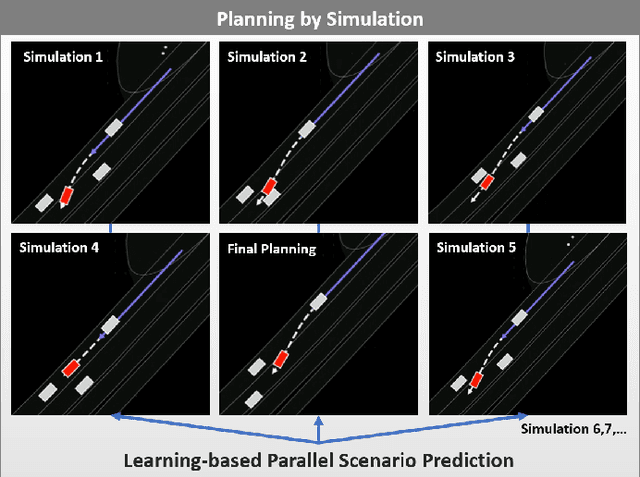
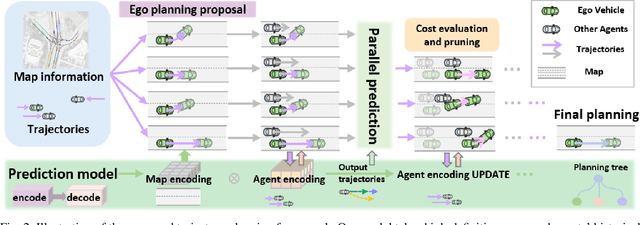

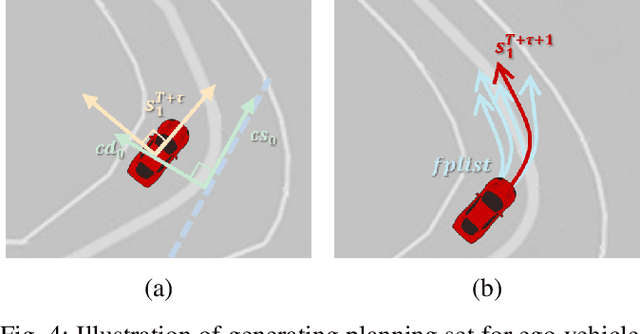
Abstract:Planning safe trajectories for autonomous vehicles is essential for operational safety but remains extremely challenging due to the complex interactions among traffic participants. Recent autonomous driving frameworks have focused on improving prediction accuracy to explicitly model these interactions. However, some methods overlook the significant influence of the ego vehicle's planning on the possible trajectories of other agents, which can alter prediction accuracy and lead to unsafe planning decisions. In this paper, we propose a novel motion Planning approach by Simulation with learning-based parallel scenario prediction (PS). PS deduces predictions iteratively based on Monte Carlo Tree Search (MCTS), jointly inferring scenarios that cooperate with the ego vehicle's planning set. Our method simulates possible scenes and calculates their costs after the ego vehicle executes potential actions. To balance and prune unreasonable actions and scenarios, we adopt MCTS as the foundation to explore possible future interactions encoded within the prediction network. Moreover, the query-centric trajectory prediction streamlines our scene generation, enabling a sophisticated framework that captures the mutual influence between other agents' predictions and the ego vehicle's planning. We evaluate our framework on the Argoverse 2 dataset, and the results demonstrate that our approach effectively achieves parallel ego vehicle planning.
SparseTem: Boosting the Efficiency of CNN-Based Video Encoders by Exploiting Temporal Continuity
Oct 28, 2024Abstract:Deep learning models have become pivotal in the field of video processing and is increasingly critical in practical applications such as autonomous driving and object detection. Although Vision Transformers (ViTs) have demonstrated their power, Convolutional Neural Networks (CNNs) remain a highly efficient and high-performance choice for feature extraction and encoding. However, the intensive computational demands of convolution operations hinder its broader adoption as a video encoder. Given the inherent temporal continuity in video frames, changes between consecutive frames are minimal, allowing for the skipping of redundant computations. This technique, which we term as Diff Computation, presents two primary challenges. First, Diff Computation requires to cache intermediate feature maps to ensure the correctness of non-linear computations, leading to significant memory consumption. Second, the imbalance of sparsity among layers, introduced by Diff Computation, incurs accuracy degradation. To address these issues, we propose a memory-efficient scheduling method to eliminate memory overhead and an online adjustment mechanism to minimize accuracy degradation. We integrate these techniques into our framework, SparseTem, to seamlessly support various CNN-based video encoders. SparseTem achieves speedup of 1.79x for EfficientDet and 4.72x for CRNN, with minimal accuracy drop and no additional memory overhead. Extensive experimental results demonstrate that SparseTem sets a new state-of-the-art by effectively utilizing temporal continuity to accelerate CNN-based video encoders.
Dual-AEB: Synergizing Rule-Based and Multimodal Large Language Models for Effective Emergency Braking
Oct 11, 2024



Abstract:Automatic Emergency Braking (AEB) systems are a crucial component in ensuring the safety of passengers in autonomous vehicles. Conventional AEB systems primarily rely on closed-set perception modules to recognize traffic conditions and assess collision risks. To enhance the adaptability of AEB systems in open scenarios, we propose Dual-AEB, a system combines an advanced multimodal large language model (MLLM) for comprehensive scene understanding and a conventional rule-based rapid AEB to ensure quick response times. To the best of our knowledge, Dual-AEB is the first method to incorporate MLLMs within AEB systems. Through extensive experimentation, we have validated the effectiveness of our method. The source code will be available at https://github.com/ChipsICU/Dual-AEB.
 Add to Chrome
Add to Chrome Add to Firefox
Add to Firefox Add to Edge
Add to Edge